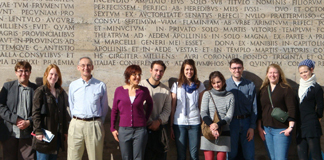
Hers is not a typical diary entry.
“The merits of firsthand exposure to the art and architecture of ancient Rome are hard to articulate, but there is something affective about the experience that raises questions and inspires critical thought beyond a textbook reading,” wrote Tracy Jennings, a senior classics major at the University of Notre Dame, in a journal she kept while traveling through Rome last fall.
But it is precisely the reaction Keith Bradley, Eli J. and Helen Shaheen Professor of Classics, was hoping to evoke in his students when he took them on a weeklong trip to the ancient city as part of “Literature and Empire: The Roman Experience”—a course he taught for the first time this fall to a group of upper-level undergraduate and graduate students.
Students in the seminar explored major works of literature from the Roman imperial era including such texts as Virgil’s “Aeneid,” Lucan’s “Civil War,” and Tacitus’ “Annals.” They examined the political and ideological contexts in which the works were written and how the authors expressed reactions to the harsh and repressive form of autocratic government that the Roman emperorship embodied.
An ancient historian who specializes in the social and cultural history of Rome, Bradley says he took the students to Rome so that they could see for themselves some of the ancient monuments for which Rome’s military monarchs were responsible and tour the major museums of Rome where representations of imperial power and magnificence are on display. Highlights included face-to-face confrontation with the Prima Porta statue of Augustus in the Vatican Museums, the great equestrian statue of the philosopher-king Marcus Aurelius in the Capitoline Museums, and the Altar of Augustan Peace in the Campus Martius, with its catalog of Augustan accomplishments that was reinscribed much later in history by the new Romanizing ruler, Mussolini.
“The idea was for the students to understand something of the topography of Rome and of what the city was like in antiquity, where all of the literary works we were studying were written or where their authors at some point lived,” Bradley explains. “And we wanted also to see as much as we could of Roman sculpture and artistic productions—mosaics and frescoes and other forms of material remains—that would help us enrich our investigation of the course’s theme.”
Bradley also wanted the students to use what they saw during their visit as part of their individual research projects.
Jennings, for example, was able to do research for her senior thesis on the nature of emperorship.
“I’m investigating how the Emperor Hadrian deified an unusual number of individuals, including his lover Antinous, and how those acts reflected on his policies and the nature of the emperorship,” Jennings says. “Seeing material evidence of deification reinforced how widely accepted this practice was in the Roman Empire, which contrasts with our modern standards of monotheism and the relationship between religion and state. My experience in Rome helped me to connect the archaeological evidence with the literary record.”
The trip also was valuable for Mary Clare Murphy, a Classics major whose senior thesis explores Ovid’s “Fasti.” Murphy had the opportunity to see the “Fasti Praenestini,” an ancient ceremonial calendar from Praeneste, just outside of Rome.
“This is the best-preserved Roman calendar, and its text reflects Augustus’ influence not only on the calendar but on all Roman life,” Murphy says. “For example, it celebrates the anniversary of the dedication of Augustus’ ‘Ara Pacis,’ or Altar of Peace. I had seen the calendar before, but now, since I was familiar with Ovid’s ‘Fasti,’ I could see how similar the two were in their constant references to the Emperor Augustus.”
Although this was the first time Bradley taught this course, it was not the first time he has taken students overseas to study on location. In fall 2008, he taught a class on the Emperor Hadrian that coincided with a special exhibition devoted to the emperor at the British Museum in London. He not only took the class to see the display, but he also says he included a side trip to the north of England so that his students could walk on Hadrian’s Wall and acquire a sense of its “remote magnificence.”
Funding for Bradley’s recent class trip to Rome came in part from Notre Dame’s Office of International Studies, the Ph.D in Literature Program, and the Institute for Scholarship in the Liberal Arts. A Learning Beyond the Classroom grant from the College of Arts and Letters helped fund the 2008 trip to London.
“One of the things that I think is truly remarkable about Notre Dame is that it makes resources available to do trips like this. In Rome, the students stayed in a fairly modest hotel, but it was right in the heart of the historical district,” Bradley says. “I think it is a tribute to Notre Dame’s vision that it makes ventures like this possible. I am very grateful to Notre Dame for the teaching enrichment opportunities it provides.”
--Story by Katie Louvat, ND Newswire